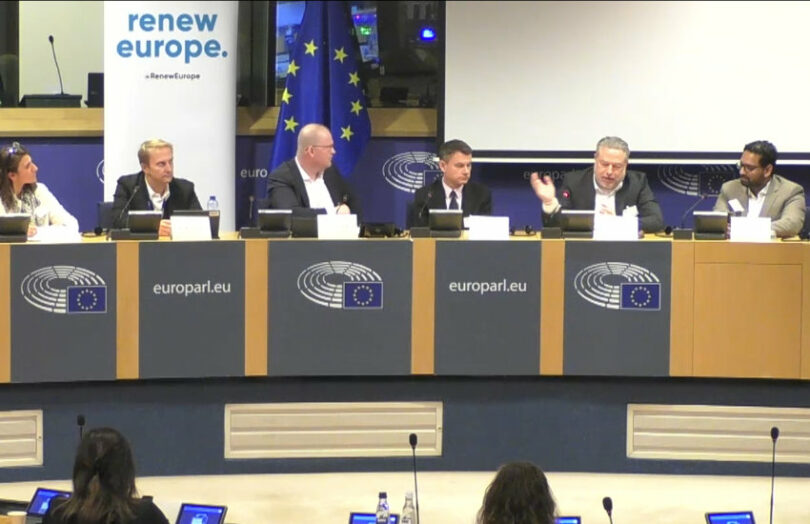Yesterday Renew Europe, the third largest parliamentary group in the European Union (EU), held a joint event with the Global Blockchain Business Council (GBBC) at the EU Parliament. A high quality industry panel explored the potential for tokenization and digital securities.
Two key takeaways related to the DLT Pilot Regime for tokenized securities and the European Commission’s thinking on legislation.
DLT Pilot Regime unsuited to large institutions?
The moderator surprised JP Morgan’s Joshua Daniel by asking why the bank wasn’t participating in the EU’s DLT Pilot Regime, which waves some regulations for digital securities. In a somewhat amusing exchange, Daniel disarmingly requested a different question. Deutsche Börse’s Jens Hachmeister explained that large financial market infrastructures (FMIs) and institutions like JP Morgan have similar challenges with sandboxes.
He metaphorically compared the institutions to aircraft carriers. What if they were asked to adapt to support Cessna aircraft and only for a couple of landings and take-offs? It’s hard for FMIs to justify the cost of getting involved on a small scale and for short periods.
“It’s probably fair to say sandboxes are not geared towards big market infrastructures and big market players,” said Hachmeister.
“Deutsche Börse likes to build infrastructure based on real and sound regulations so that we ensure our investments … pay off”.
This echoes the sentiment of others, such as BNY Mellon that made similar comments in 2022. However, recently Goldman Sachs sounded more positive on the topic. The UK is also launching a Digital Securities Sandbox but has been more vague about limits. Noting the pushback re the DLT Pilot Regime, the UK said it plans to adapt to the scale of the firms involved.
Separate from the DLT Pilot Regime, the European Central Bank (ECB) is running some DLT settlement trials using central bank money based on current regulations. Hence, it only involves institutions that can already access central bank money. Hachmeister added that Deutsche Börse will definitely participate in these trials.
Are DLT and digital securities disruptive?
The Deutsche Börse Clearstream executive also gave an update on the progress of D7, the company’s digital securities post trade platform. So far, it has issued 15,000 securities, including one big bond of around €3 billion. While these are digital, they are issued on a central repository with plans to issue on a decentralized network in the future. Most of the securities are structured products, and our research indicates that about 99% of the issuances are by a single institution, Vontobel Financial Products.
Asked whether DLT is a disruptive technology, Hachmeister defined disruptive as the ability to change how value is created and allocated in an industry.
He compared it to when securities trading went from physical to electronic. Market efficiencies led to significant growth. “Bigger volumes, tighter spreads, more securities issued,” he said. “I believe When we talk about digital securities service infrastructure, it is the next level of the S curve, the next level of market efficiency.”
However, he highlighted that DLT isn’t a panacea. It needs to either earn new revenues or save money. “To me, the question is not whether you use DLT or not. The question is whether you can provide a measurable value add to the client.”
About being disruptive, he said “DLT is one of those technologies,” emphasizing it is not standalone. But he added that “it needs more things to fall into place.”
DeFi regulation unlikely soon?
One of the other speakers was European Commission advisor Peter Kerstens. He discussed the need for the European Commission to publish a report on the MiCA crypto regulation by December. It might express ideas about decentralized finance (DeFi), NFTs, crypto lending and staking.
“The likelihood that it will say something meaningful on decentralized finance is limited because true decentralization escapes regulatory dogma,” said Kerstens. He highlighted that worldwide rules are administered via intermediaries, which are absent in truly decentralized solutions. In fact, he said that DeFi is defined not by technology but by the absence of an intermediary. In many cases, when you scratch below the surface you can find an intermediary, and the best example of a decentralized network is Bitcoin.
“That’s why it’s very hard, if not impossible, to actually regulate it using existing doctrines of regulation. Unless, of course, you are a totalitarian state and you just ban it.” He added, “It’s unlikely that we would have a legal basis in the Treaty to propose a ban if we wanted to.”
Will clearinghouses be disintermediated?
He also responded to a question about whether clearinghouses might be disintermediated. “Clearinghouses are a risk mitigation effort,” said Kerstens. So, if the technology stack develops and the business model develops in such a way that the risks currently caught by clearinghouses are no longer in the system, then you can do away with the clearinghouse. But if that risk is still there, you need a clearinghouse.”
Kerstns also posed the question of what would happen if FMIs didn’t have all the current legacy infrastructure. “If you had to start from a clean slate, I am convinced that DLT would be a much, much bigger part of the technology stack.”






